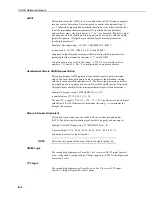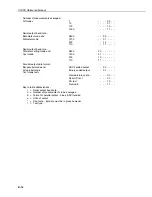
CR10X Reference Manual
B-8
port used for the RTS/DTR line; the Serial Output and Serial Input are the next two
consecutive ports, respectively. Three control ports are used per repetition.
Table B-2 Input/Output Configurations
Configuration
Parameters
Port Function
Ports
Number
3
6
8
RTS/DTR
CTS
TX
RX
Used
1
DTR,RX
x
0
nz
C
nc
nc
C+1
2
2
DTR,TX
nz
nz
0
C
nc
C+1
nc
2
3
DTR,CTS,TX
0
nz
0
C
C+1
C+2
nc
3
4
DTR,TX, RX
nz
nz
nz
C
nc
C+1
C+2
3
5
DTR,CTS,TX,RX
0
nz
nz
C
C+1
C+2
C+3
4
RTS/DTR
= Request to Send
TX
= serial output
/Data Terminal Ready
RX
= serial input
CTS
= Clear to Send
nz
= non-zero number
x
= don’t care
nc
= not connected
C
= first control port
Parameter 3
= CTS/Delay before send
Parameter 6
= Number of locations to send
Parameter 8
= Maximum number of characters to receive
‘C’ is incremented by the number of ports used for each repetition.
B.3.5 Configuration 5
Serial data is output and received by the CR10X. The CTS line is used. Parameter
3 must be zero, while parameters 6 and 8 must be greater than zero. Parameter 4
specifies the control port used for the RTS/DTR line, the next port is for CTS, and
the third and fourth ports are for Serial Output and Serial Input, respectively. Four
control ports are used per repetition.
B.4 Program Examples
The following examples represent portions of a larger, more complete application
program, and should be adapted for your application.
B.4.1 Example 1: Atmospheric Instruments Research
AIR-DB-1A Barometer
Various barometer functions (mode, units of output, baud rate, etc.) are deter-
mined by jumpers internal to the barometer. A summary of the jumper configura-
tions is given in Section B.5. Detailed instructions for jumper placement are found
in the AIR Barometer Operations Manual provided by AIR, Inc.
B.4.1.1 CR10X / Barometer Configuration Limitations
The CR10X is limited to reading only certain barometer jumper configurations as
described below:
















































